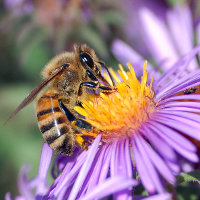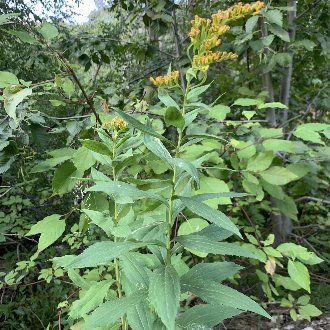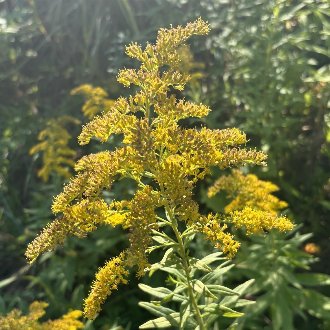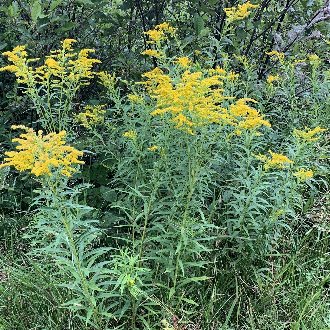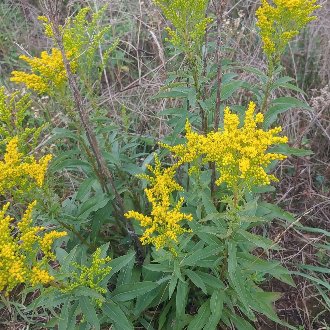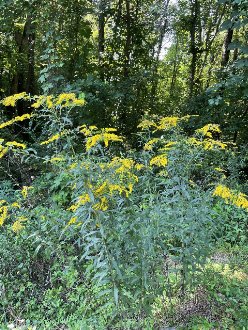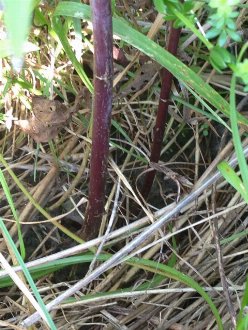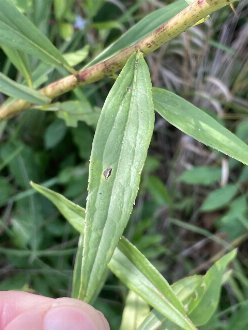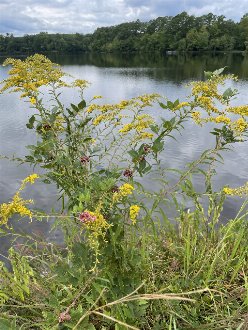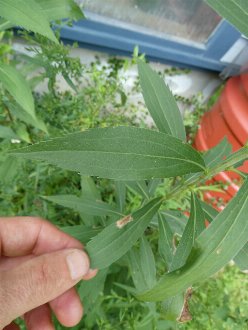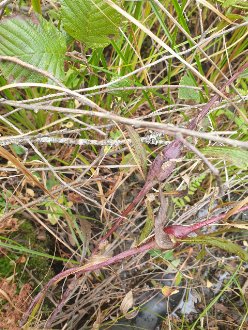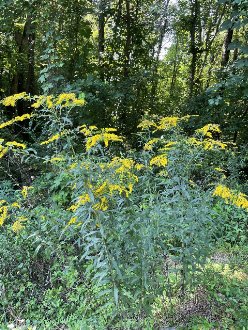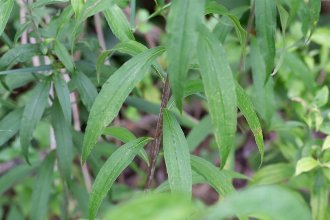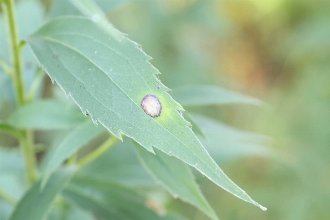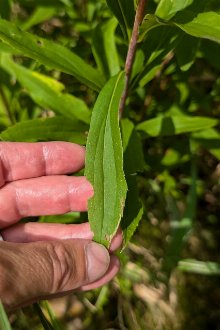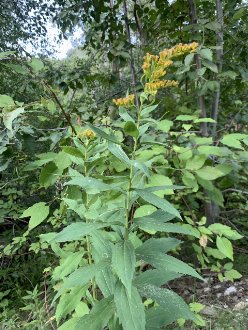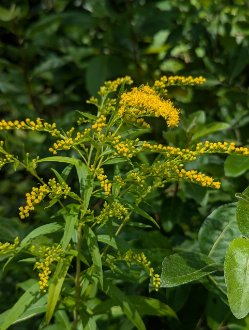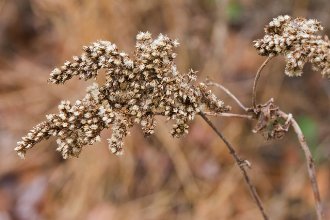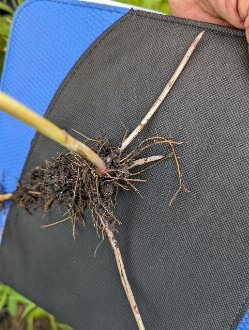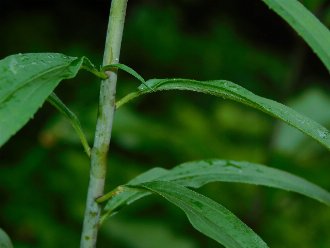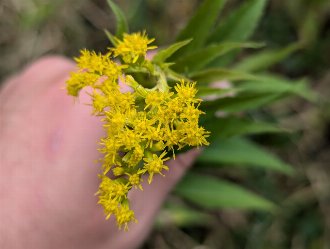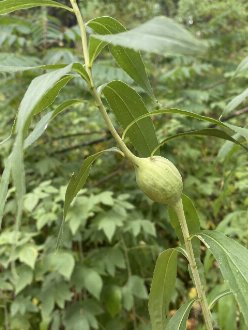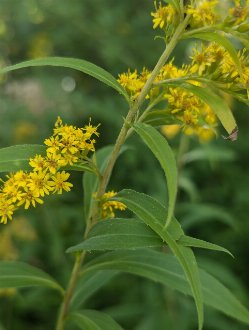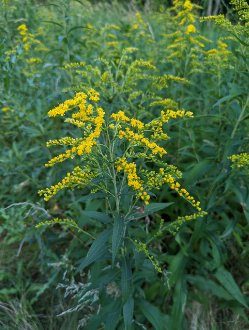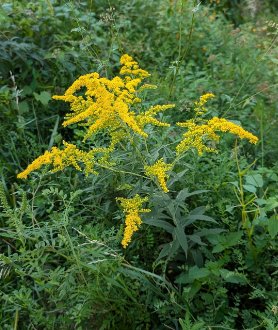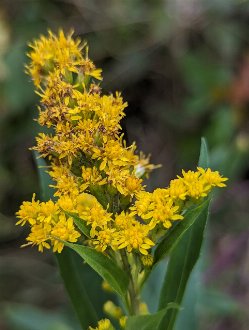Giant Goldenrod (Solidago gigantea Aiton)
Also known as smooth goldenrod.
↑Summary
A large, aggressive perennial of moist, rich sites, native to a wide range in North America.
↑Range - Expand
| Legend | Color |
| Native | |
| Native or Not Present |
This tentative map is based on our own research. It may have limited data on Canada and/or Mexico, and there is some subjectivity in our assignment of plants as introduced vs. expanded. Read more in this blog post.
Although this plant occurs somewhere in each of these regions, it may only occur in a small part of some or all of them.
↑Similar Plants
↑Habitat
Giant goldenrod occurs in rich bottomlands on moist to wet sites in full sun to light shade. Natural habitats include openings in floodplain forests, swamps in the floodplains of major rivers, shorelines of bodies of water, wet prairies, swales, and ditches. It is less common in anthropogenic habitats, but it occurs in wet portions of old fields, ditches, and wet depressions in unmaintained portions of gardens.
Although it can occur both along moving water and near standing water, it is mostly restricted to soils with at least moderate mineral availability and pH, which can occur either along streams or rivers, or in fens where groundwater brings minerals. It is absent from bogs and other strongly-acidic wetlands with low mineral nutrient availability. It also is less tolerant of salinity and is thus absent from shores of estuaries and coastal areas exposed to salt spray.
It prefers rich soils and is usually only found on well-developed soil with significant organic matter, but can tolerate some range of soil textures including loam, clay-loam, silt-loam, and sandy loam.
It tolerates temporary flooding in winter and early spring, but is absent from the lowest sites in floodplains that flood for prolonged periods of time and/or during the growing season.
It tends to grow in habitats where there is intense competition from other ground-level herbaceous vegetation, as well as some shade from both trees and shrubs. However, it is absent from habitats with deer overpopulation.
↑Life Cycle
Giant goldenrod is a tall, colony-forming long-rhizomatous perennial. Relative to the other colony-forming goldenrods, it invests less in seed production and more in vegetative reproduction.
Stems of mature plants reach to about 7 feet (over 2m) in height, but will often lean or flop in the absence of supporting vegetation. The leaning of stems in this species is called "ducking", and is a variable trait exhibited by a little more than 3/4 of plants. Ducking stems will initially grow upright, but then nod and point downward for several weeks, only to straighten out right before the plant blooms. It is not known exactly why this plant exhibits this behavior, but there is some evidence it may discourage the targeting of this plant by gall-forming insects; this species exhibits this behavior more than tall goldenrod (Solidago altissima), and exhibits galls less than that species.
Established plants reproduce vegetatively through rhizomes, typically forming colonies of up to 20 stems, rarely more.
This species tends to be one of the earliest blooming of the goldenrods, in most regions blooming almost as early as early goldenrod (Solidago juncea), which grows in drier habitats. It is typically the first goldenrod to bloom in the moister habitats where it occurs. The seed is dispersed both by wind and water.
Because the habitats where this species occurs tend to be dynamic, individual stems frequently die due to shading, competition, flooding, or shifting soils, but the plant as a whole is much longer-lived. We could not find any information on the specific lifespan of this plant, but it is likely highly variable based on the stability of the conditions that favors this plant.
Towards the dry end of its habitat preferences, plants are more likely to die from shading and competition from other vegetation more adapted to mesic conditions, whereas towards the wet end, it is more likely to die from flooding. However, colonies of this plant usually only die if it has nowhere to move to, as it can move several feet per season to find suitable habitat as conditions change incrementally. Herbivore pressure can also harm this plant, as it is less resistant to browsing than a number of other species that occur in its habitat. Heavy browsing can eliminate this plant, especially where it is competing directly with other more browse-resistant plants.
↑Faunal Associations
The foliage and young stems are browsed by white-tailed deer, meadow vole, and muskrat. Mature colonies later in the growing season provide cover for wildlife.
As with other Solidago sp., the flowers attract a large number and variety of insect pollinators, including bumblebees, long-horned bees of the Melissodes and Svastra genera, Halictid bees, Calliopsis bees, Protandrena bees, Andrenid (mining) bees, Syrphid flies, and wasps. Numerous insects feed destructively on the various parts of the plant as well.
↑Links & External Resources
• Solidago gigantea (Giant Goldenrod) | Illinois Wildflowers (About This Site)
• Solidago gigantea (Giant Goldenrod) | USDA PLANTS Database (About This Site)
• Solidago gigantea | Go Botany (About This Site)
• Solidago gigantea (Early Goldenrod) | Missouri Botanical Garden Plant Finder (About This Site)
• Solidago gigantea | Biota of North America Project (BONAP) (About This Site)
• Solidago gigantea | NatureServe Explorer (About This Site)
• Solidago gigantea | Flora of North America (About This Site)
• Giant Goldenrod | Maryland Biodiversity Project (About This Site)
• Solidago gigantea (Giant Goldenrod) | Minnesota Wildflowers (About This Site)
• Solidago gigantea Ait. (Late Goldenrod) | Digital Atlas of the Virginia Flora (About This Site)

